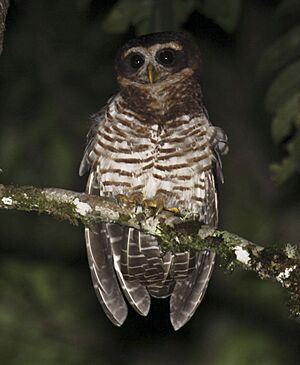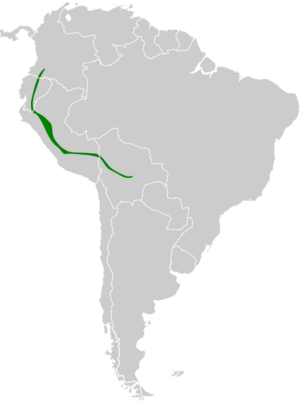Band-bellied owl facts for kids
Quick facts for kids Band-bellied owl |
|
|---|---|
 |
|
| Conservation status | |
| Scientific classification | |
| Genus: |
Pulsatrix
|
| Species: |
melanota
|
 |
|
Meet the band-bellied owl (Pulsatrix melanota)! This amazing bird is a type of owl that belongs to the Strigidae family. You can find it living in parts of South America, like Bolivia, Colombia, Ecuador, and Peru.
Contents
What Kind of Owl Is It?
The band-bellied owl is part of a group of owls called Pulsatrix. It has two main types, or subspecies: P. m. melanota and P. m. philoscia. Think of them like different versions of the same owl!
What Does It Look Like?
The band-bellied owl is a fairly large bird. It can be about 44 to 48 centimeters (17 to 19 inches) long. These owls usually weigh between 590 and 1250 grams (about 1.3 to 2.8 pounds). The average weight is around 873 grams (1.9 pounds).
Adult band-bellied owls have a dark brown face. They have cool white "eyebrows" above their dark reddish-brown eyes. Their upper body is dark chocolate brown with some scattered buffy-white spots. Their tail is also dark brown with thin white stripes. The upper part of their chest is reddish-brown with buff stripes. The rest of their belly is white or creamy with reddish-brown stripes. We don't have much information about what young band-bellied owls look like yet.
Where Does It Live?
The P. m. melanota subspecies lives on the eastern side of the Andes mountains. You can find it from central Colombia, south through Ecuador, and into Peru. The P. m. philoscia subspecies lives further south, from Peru to west-central Bolivia.
These owls prefer to live in humid montane forests, which are forests found in mountains. They also live in foothills rainforests. Sometimes, you can spot them at the edges of forests or in clearings where there are still some trees. They usually live at elevations from about 650 to 2200 meters (2,100 to 7,200 feet) above sea level.
How Does It Behave?
What Does It Eat?
The band-bellied owl is a nocturnal animal, which means it is active at night. We don't know a lot about what it eats, but we do know that it enjoys large insects.
How Does It Raise Its Young?
There isn't much published information about how the band-bellied owl breeds. However, scientists believe that these owls probably make their nests in natural holes found in trees.
What Does It Sound Like?
The sounds of the band-bellied owl are also not very well known. People say it makes a short, deep trill followed by a fast burst of popping sounds. Deep, muffled hoots have also been heard in Peru. Sometimes, male and female owls will sing together in what's called a duet.
Is It Endangered?
The IUCN (International Union for Conservation of Nature) has listed the band-bellied owl as a species of "Least Concern." This means it's not currently considered to be in danger of disappearing. However, we still don't know a lot about this owl. Scientists worry that it "could be threatened by habitat loss," which means losing the places where it lives.


